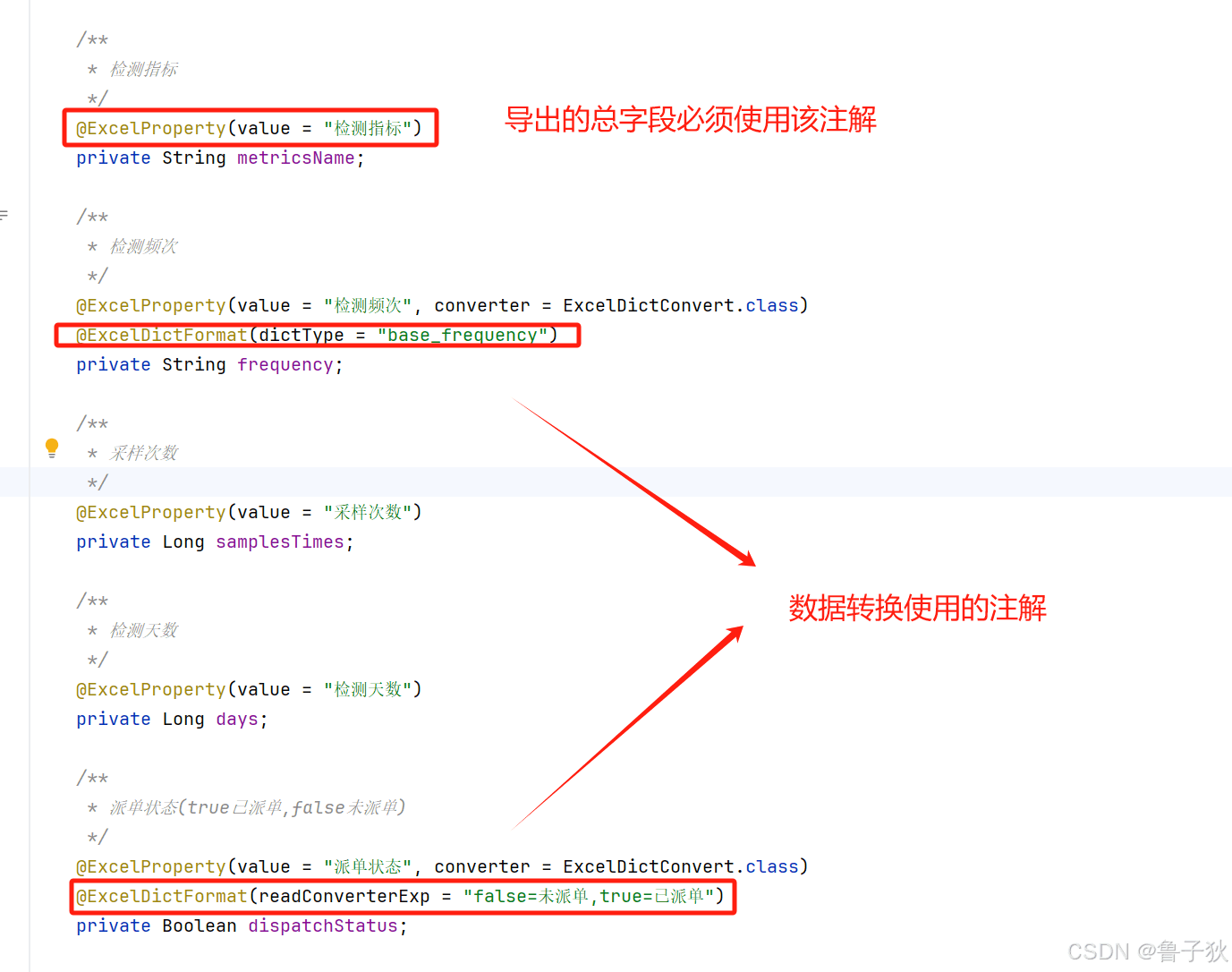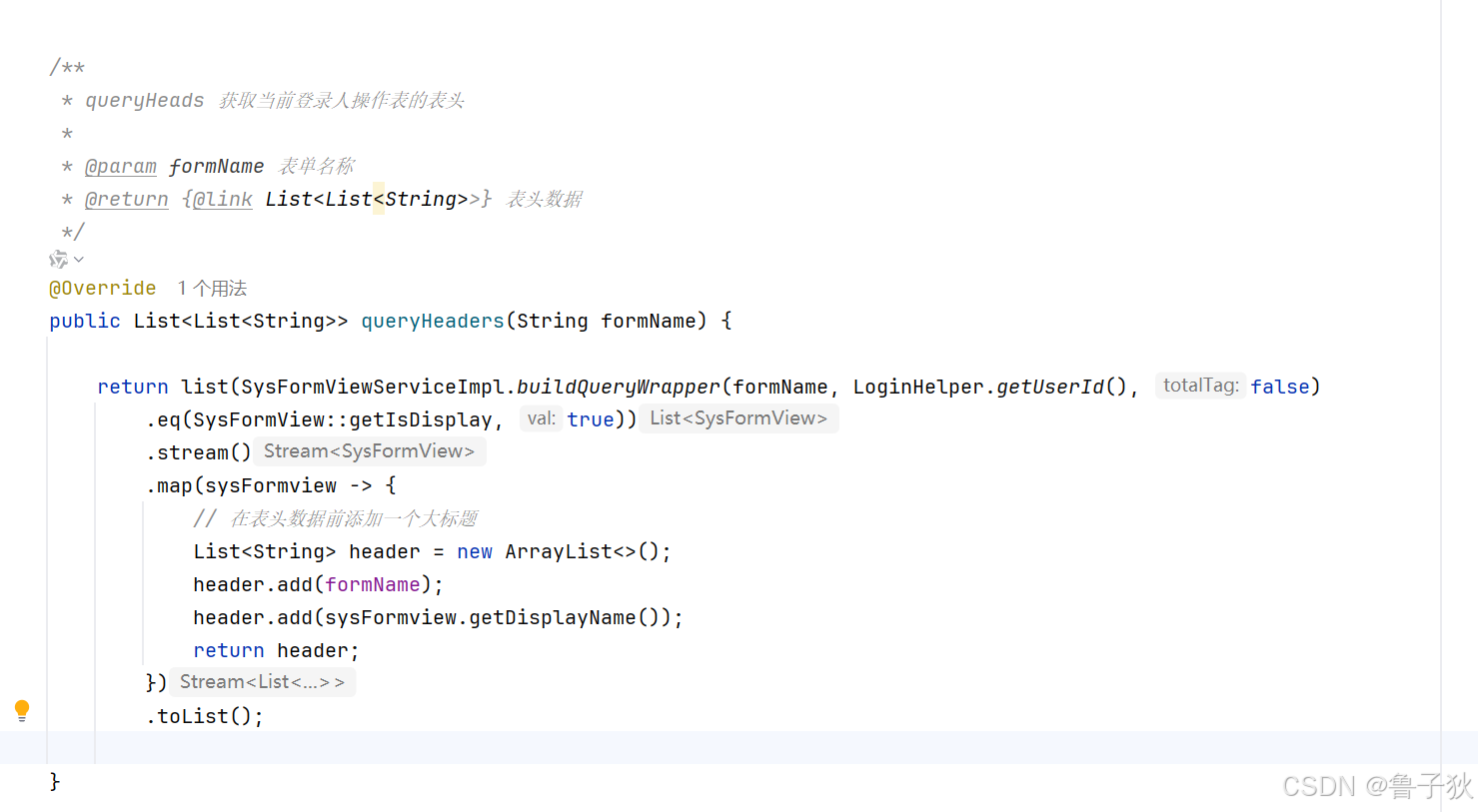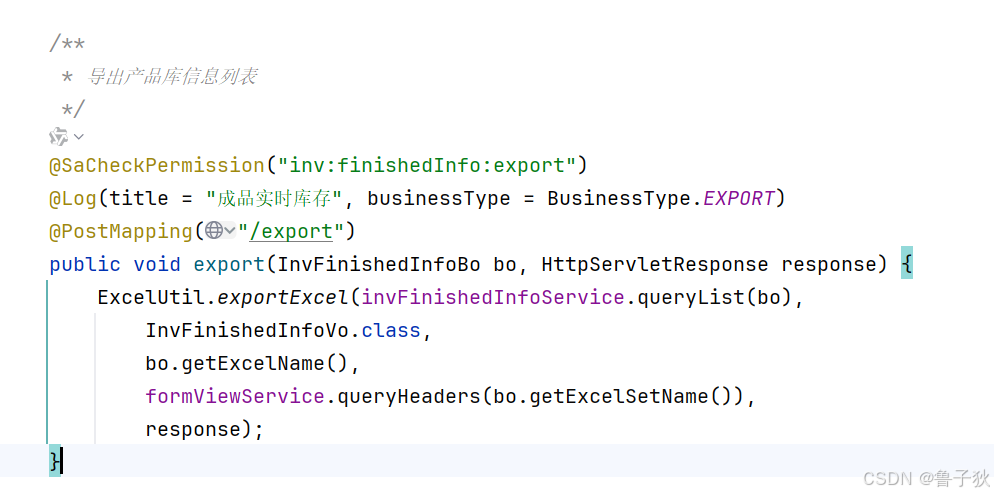springboot3 使用 easyexcel 封装工具类实现 自定义表头 导出并实现 数据格式化转换 与 添加下拉框 操作
在现代企业应用中,数据导出功能是非常常见的需求。特别是在处理大量数据时,将数据导出为 excel 文件不仅方便用户查看和分析,还能提高数据处理的效率。apache poi 是一个常用的 java excel 处理库,但它在处理大数据量时性能较差。为此,阿里巴巴开源了 easyexcel,这是一个基于 java 的简单、优雅的 excel 操作库,它在处理大数据量时表现优异。
本文将详细介绍如何使用 easyexcel 实现自定义表头导出,并实现数据格式化转换。
官网 : easyexcel
封装了很多导出方法针对不同的业务场景,这里直接展示自定义表头的代码 .
1. 使用示例
vo 示例(部分字段)

使用方法 export
用户自定义表头的 字段显示名称 , 需跟导出注解 @excelproperty 的 value 相对应 , 不然无法取到值

页面显示数据

导出 excel 数据

2. 工具类
/**
* excel相关处理
*
* @author 鲁子狄
*/
@noargsconstructor(access = accesslevel.private)
public class excelutil {
/**
* 导出 excel 文件
*
* @param list 导出数据集合
* @param sheetname 工作表的名称
* @param heads 表头
* @param response 响应体
*/
public static <t> void exportexcel(list<t> list, class<t> clazz, string sheetname, list<list<string>> heads, httpservletresponse response) {
try {
// 将对象列表转换为自定义的数据列表
list<list<object>> data = excelutil.convertobjectstoexcelrows(list, heads);
// 重置响应体,设置响应头
excelutil.resetresponse(sheetname, response);
// 获取响应输出流
servletoutputstream os = response.getoutputstream();
// 导出 excel 文件
excelutil.exportexcel(data, clazz, heads, sheetname, false, os, null);
} catch (ioexception e) {
throw new runtimeexception("导出 excel 异常");
}
}
/**
* 重置响应体
*/
private static void resetresponse(string sheetname, httpservletresponse response) throws unsupportedencodingexception {
string filename = excelutil.encodingfilename(sheetname);
fileutils.setattachmentresponseheader(response, filename);
response.setcontenttype("application/vnd.openxmlformats-officedocument.spreadsheetml.sheet;charset=utf-8");
}
/**
* 导出 excel 文件
*
* @param data 导出数据集合
* @param heads 表头
* @param sheetname 工作表的名称
* @param merge 是否合并单元格
* @param os 输出流
* @param options 级联下拉选内容
*/
public static <t> void exportexcel(list<list<object>> data, class<t> clazz, list<list<string>> heads, string sheetname, boolean merge,
outputstream os, list<dropdownoptions> options) {
excelwritersheetbuilder builder = easyexcel.write(os, clazz)
.autoclosestream(false)
// 自动适配列宽
.registerwritehandler(new longestmatchcolumnwidthstylestrategy())
// 大数值自动转换,防止失真
.registerconverter(new excelbignumberconvert())
.sheet(sheetname)
.head(heads);
if (merge) {
// 注册合并单元格处理器
builder.registerwritehandler(new cellmergestrategy(data, true));
}
// 添加下拉框操作
builder.registerwritehandler(new exceldownhandler(options, heads));
// 写入数据
builder.dowrite(data);
}
/**
* convertobjectstoexcelrows 将对象列表转换为 excel 行数据
*
* @param list 对象集合
* @param heads 表头
* @return {@link list<list<object>>} excel 行数据
*/
private static <t> list<list<object>> convertobjectstoexcelrows(list<t> list, list<list<string>> heads) {
return list.stream()
// 将对象转换为 map
.map(excelutil::convertobjecttomap)
.map(map -> {
list<object> row = new arraylist<>();
for (list<string> header : heads) {
// 假设表头只有一个元素
string key = header.get(0);
// 根据表头获取对应的值
row.add(map.get(key));
}
return row;
})
.tolist();
}
/**
* convertobjecttomap 将对象转换为 map,键为 @excelproperty 注解中的列标题,值为字段值。
*
* @param vo 对象
* @return {@link map<string,object>} 包含列标题和字段值的 map
*/
private static map<string, object> convertobjecttomap(object vo) {
// 获取对象的所有字段
return arrays.stream(vo.getclass().getdeclaredfields())
// 过滤带有 @excelproperty 注解的字段
.filter(field -> field.isannotationpresent(excelproperty.class))
.map(field -> {
try {
// 设置字段可访问
field.setaccessible(true);
// 获取字段名和值
string fieldname = field.getdeclaredannotation(excelproperty.class).value()[0];
object fieldvalue = field.get(vo);
// 检查是否有 @exceldictformat 注解
exceldictformat dictformat = field.getdeclaredannotation(exceldictformat.class);
if (dictformat != null && fieldvalue != null) {
fieldvalue = convertexceldictformat(fieldvalue, dictformat);
}
return new abstractmap.simpleentry<>(fieldname, fieldvalue);
} catch (illegalaccessexception e) {
throw new illegalstateexception("获取字段值失败: " + field.getname(), e);
}
})
// 过滤掉值为 null 的条目
.filter(entry -> entry.getvalue() != null)
.collect(collectors.tomap(
// 键为字段名
abstractmap.simpleentry::getkey,
// 值为字段值
abstractmap.simpleentry::getvalue,
// 如果键重复,保留第一个值
(existing, replacement) -> existing,
// 使用 hashmap 存储结果
hashmap::new
));
}
/**
* converttoexceldata 根据 @exceldictformat 注解转换数据
*
* @param value 字段值
* @param dictformat 注解信息
* @return 转换后的值
*/
private static string convertexceldictformat(object value, exceldictformat dictformat) {
string type = dictformat.dicttype();
string label;
if (stringutils.isblank(type)) {
label = convertbyexp(value.tostring(), dictformat.readconverterexp(), dictformat.separator());
} else {
label = springutils.getbean(dictservice.class).getdictlabel(type, value.tostring(), dictformat.separator());
}
return label;
}
}
/**
* 解析导出值 0=男,1=女,2=未知
*
* @param propertyvalue 参数值
* @param converterexp 翻译注解
* @param separator 分隔符
* @return 解析后值
*/
public static string convertbyexp(string propertyvalue, string converterexp, string separator) {
stringbuilder propertystring = new stringbuilder();
string[] convertsource = converterexp.split(stringutils.separator);
for (string item : convertsource) {
string[] itemarray = item.split("=");
if (stringutils.containsany(propertyvalue, separator)) {
for (string value : propertyvalue.split(separator)) {
if (itemarray[0].equals(value)) {
propertystring.append(itemarray[1] + separator);
break;
}
}
} else {
if (itemarray[0].equals(propertyvalue)) {
return itemarray[1];
}
}
}
return stringutils.stripend(propertystring.tostring(), separator);
}注意
- 在使用
easyexcel导出 excel 文件时,converttoexceldata方法的调用与否取决于你如何传递数据以及数据的结构。 - 传入单个对象或对象列表时
- 当你传入一个对象列表(如
list<user>),easyexcel会根据对象的属性和字段上的注解来决定如何处理每个字段。如果某个字段上有@exceldictformat注解,并且你已经注册了相应的转换器(如exceldictconvert),那么easyexcel会在导出时调用converttoexceldata方法。- 传入嵌套列表
list<list<object>>时 (自定义表头使用) - 当你传入一个嵌套列表
list<list<object>>时,easyexcel不会自动解析对象的属性和字段注解。这是因为list<list<object>>是一个二维数组,每个元素都是一个object,easyexcel无法知道这些object应该如何转换。 - 因为自定义表头使用
list<list<object>>, 所以我的解决方案(convertobjecttomap方法)是:map表示动态数据:将list<list<object>>转换为list<map<string, object>>,其中键是字段名,值是字段值。- 手动调用转换器:在导出数据之前,手动调用
converttoexceldata方法进行数据转换。
- 传入嵌套列表
3. excelbignumberconvert 大数值自动转换,防止失真
/**
* 大数值转换
* excel 数值长度位15位 大于15位的数值转换位字符串
*/
@slf4j
public class excelbignumberconvert implements converter<long> {
@override
public class<long> supportjavatypekey() {
return long.class;
}
@override
public celldatatypeenum supportexceltypekey() {
return celldatatypeenum.string;
}
@override
public long converttojavadata(readcelldata<?> celldata, excelcontentproperty contentproperty, globalconfiguration globalconfiguration) {
return convert.tolong(celldata.getdata());
}
@override
public writecelldata<object> converttoexceldata(long object, excelcontentproperty contentproperty, globalconfiguration globalconfiguration) {
if (objectutil.isnotnull(object)) {
string str = convert.tostr(object);
if (str.length() > 15) {
return new writecelldata<>(str);
}
}
writecelldata<object> celldata = new writecelldata<>(new bigdecimal(object));
celldata.settype(celldatatypeenum.number);
return celldata;
}
}4. cellmergestrategy 注册合并单元格处理器
**
* 列值重复合并策略
*/
@slf4j
public class cellmergestrategy extends abstractmergestrategy implements workbookwritehandler {
private final list<cellrangeaddress> celllist;
private final boolean hastitle;
private int rowindex;
public cellmergestrategy(list<?> list, boolean hastitle) {
this.hastitle = hastitle;
// 行合并开始下标
this.rowindex = hastitle ? 1 : 0;
this.celllist = handle(list, hastitle);
}
@override
protected void merge(sheet sheet, cell cell, head head, integer relativerowindex) {
//单元格写入了,遍历合并区域,如果该cell在区域内,但非首行,则清空
final int rowindex = cell.getrowindex();
if (collutil.isnotempty(celllist)){
for (cellrangeaddress celladdresses : celllist) {
final int firstrow = celladdresses.getfirstrow();
if (celladdresses.isinrange(cell) && rowindex != firstrow){
cell.setblank();
}
}
}
}
@override
public void afterworkbookdispose(final workbookwritehandlercontext context) {
//当前表格写完后,统一写入
if (collutil.isnotempty(celllist)){
for (cellrangeaddress item : celllist) {
context.getwritecontext().writesheetholder().getsheet().addmergedregion(item);
}
}
}
@sneakythrows
private list<cellrangeaddress> handle(list<?> list, boolean hastitle) {
list<cellrangeaddress> celllist = new arraylist<>();
if (collutil.isempty(list)) {
return celllist;
}
field[] fields = reflectutils.getfields(list.get(0).getclass(), field -> !"serialversionuid".equals(field.getname()));
// 有注解的字段
list<field> mergefields = new arraylist<>();
list<integer> mergefieldsindex = new arraylist<>();
for (int i = 0; i < fields.length; i++) {
field field = fields[i];
if (field.isannotationpresent(cellmerge.class)) {
cellmerge cm = field.getannotation(cellmerge.class);
mergefields.add(field);
mergefieldsindex.add(cm.index() == -1 ? i : cm.index());
if (hastitle) {
excelproperty property = field.getannotation(excelproperty.class);
rowindex = math.max(rowindex, property.value().length);
}
}
}
map<field, repeatcell> map = new hashmap<>();
// 生成两两合并单元格
for (int i = 0; i < list.size(); i++) {
for (int j = 0; j < mergefields.size(); j++) {
field field = mergefields.get(j);
object val = reflectutils.invokegetter(list.get(i), field.getname());
int colnum = mergefieldsindex.get(j);
if (!map.containskey(field)) {
map.put(field, new repeatcell(val, i));
} else {
repeatcell repeatcell = map.get(field);
object cellvalue = repeatcell.getvalue();
if (cellvalue == null || "".equals(cellvalue)) {
// 空值跳过不合并
continue;
}
if (!cellvalue.equals(val)) {
if ((i - repeatcell.getcurrent() > 1)) {
celllist.add(new cellrangeaddress(repeatcell.getcurrent() + rowindex, i + rowindex - 1, colnum, colnum));
}
map.put(field, new repeatcell(val, i));
} else if (i == list.size() - 1) {
if (i > repeatcell.getcurrent() && ismerge(list, i, field)) {
celllist.add(new cellrangeaddress(repeatcell.getcurrent() + rowindex, i + rowindex, colnum, colnum));
}
} else if (!ismerge(list, i, field)) {
if ((i - repeatcell.getcurrent() > 1)) {
celllist.add(new cellrangeaddress(repeatcell.getcurrent() + rowindex, i + rowindex - 1, colnum, colnum));
}
map.put(field, new repeatcell(val, i));
}
}
}
}
return celllist;
}
private boolean ismerge(list<?> list, int i, field field) {
boolean ismerge = true;
cellmerge cm = field.getannotation(cellmerge.class);
final string[] mergeby = cm.mergeby();
if (strutil.isallnotblank(mergeby)) {
//比对当前list(i)和list(i - 1)的各个属性值一一比对 如果全为真 则为真
for (string fieldname : mergeby) {
final object valcurrent = reflectutil.getfieldvalue(list.get(i), fieldname);
final object valpre = reflectutil.getfieldvalue(list.get(i - 1), fieldname);
if (!objects.equals(valpre, valcurrent)) {
//依赖字段如有任一不等值,则标记为不可合并
ismerge = false;
}
}
}
return ismerge;
}
@data
@allargsconstructor
static class repeatcell {
private object value;
private int current;
}
}5. exceldownhandler 添加下拉框操作


/**
* <h1>excel表格下拉选操作</h1>
* 考虑到下拉选过多可能导致excel打开缓慢的问题,只校验前1000行
* <p>
* 即只有前1000行的数据可以用下拉框,超出的自行通过限制数据量的形式,第二次输出
*/
@slf4j
public class exceldownhandler implements sheetwritehandler {
/**
* excel表格中的列名英文
* 仅为了解析列英文,禁止修改
*/
private static final string excel_column_name = "abcdefghijklmnopqrstuvwxyz";
/**
* 单选数据sheet名
*/
private static final string options_sheet_name = "options";
/**
* 联动选择数据sheet名的头
*/
private static final string linked_options_sheet_name = "linkedoptions";
/**
* 下拉可选项
*/
private final list<dropdownoptions> dropdownoptions;
/**
* 表头
*/
private final list<list<string>> heads;
/**
* 当前单选进度
*/
private int currentoptionscolumnindex;
/**
* 当前联动选择进度
*/
private int currentlinkedoptionssheetindex;
private final dictservice dictservice;
public exceldownhandler(list<dropdownoptions> options, list<list<string>> heads) {
dropdownoptions = options;
this.heads = heads;
currentoptionscolumnindex = 0;
currentlinkedoptionssheetindex = 0;
dictservice = springutils.getbean(dictservice.class);
}
/**
* <h2>开始创建下拉数据</h2>
* 1.通过解析传入的@excelproperty同级是否标注有@dropdown选项
* 如果有且设置了value值,则将其直接置为下拉可选项
* <p>
* 2.或者在调用excelutil时指定了可选项,将依据传入的可选项做下拉
* <p>
* 3.二者并存,注意调用方式
*/
@override
public void aftersheetcreate(writeworkbookholder writeworkbookholder, writesheetholder writesheetholder) {
sheet sheet = writesheetholder.getsheet();
// 开始设置下拉框 hssfworkbook
datavalidationhelper helper = sheet.getdatavalidationhelper();
workbook workbook = writeworkbookholder.getworkbook();
fieldcache fieldcache = classutils.declaredfields(writeworkbookholder.getclazz(), writeworkbookholder);
for (map.entry<integer, fieldwrapper> entry : fieldcache.getsortedfieldmap().entryset()) {
integer index = entry.getkey();
fieldwrapper wrapper = entry.getvalue();
field field = wrapper.getfield();
// 循环实体中的每个属性
// 可选的下拉值
list<string> options = new arraylist<>();
if (field.isannotationpresent(exceldictformat.class)) {
// 如果指定了@exceldictformat,则使用字典的逻辑
exceldictformat format = field.getdeclaredannotation(exceldictformat.class);
string dicttype = format.dicttype();
string converterexp = format.readconverterexp();
if (stringutils.isnotblank(dicttype)) {
// 如果传递了字典名,则依据字典建立下拉
collection<string> values = optional.ofnullable(dictservice.getalldictbydicttype(dicttype))
.orelsethrow(() -> new serviceexception(string.format("字典 %s 不存在", dicttype)))
.values();
options = new arraylist<>(values);
} else if (stringutils.isnotblank(converterexp)) {
// 如果指定了确切的值,则直接解析确切的值
list<string> strlist = stringutils.splitlist(converterexp, format.separator());
options = streamutils.tolist(strlist, s -> stringutils.split(s, "=")[1]);
}
} else if (field.isannotationpresent(excelenumformat.class)) {
// 否则如果指定了@excelenumformat,则使用枚举的逻辑
excelenumformat format = field.getdeclaredannotation(excelenumformat.class);
list<object> values = enumutil.getfieldvalues(format.enumclass(), format.textfield());
options = streamutils.tolist(values, string::valueof);
}
if (objectutil.isnotempty(options)) {
// 如过自定义表头不为空
if (collutil.isnotempty(heads)) {
// 获取对应的下拉表头的下标
index = intstream.range(0, heads.size())
.filter(i -> wrapper.getheads()[0].equals(heads.get(i).get(0)))
.findfirst().orelse(0);
}
// 仅当下拉可选项不为空时执行
if (options.size() > 20) {
// 这里限制如果可选项大于20,则使用额外表形式
dropdownwithsheet(helper, workbook, sheet, index, options);
} else {
// 否则使用固定值形式
dropdownwithsimple(helper, sheet, index, options);
}
}
}
if (collutil.isempty(dropdownoptions)) {
return;
}
dropdownoptions.foreach(everyoptions -> {
// 如果传递了下拉框选择器参数
if (!everyoptions.getnextoptions().isempty()) {
// 当二级选项不为空时,使用额外关联表的形式
dropdownlinkedoptions(helper, workbook, sheet, everyoptions);
} else if (everyoptions.getoptions().size() > 10) {
// 当一级选项参数个数大于10,使用额外表的形式
dropdownwithsheet(helper, workbook, sheet, everyoptions.getindex(), everyoptions.getoptions());
} else if (!everyoptions.getoptions().isempty()) {
// 当一级选项个数不为空,使用默认形式
dropdownwithsimple(helper, sheet, everyoptions.getindex(), everyoptions.getoptions());
}
});
}
/**
* <h2>简单下拉框</h2>
* 直接将可选项拼接为指定列的数据校验值
*
* @param celindex 列index
* @param value 下拉选可选值
*/
private void dropdownwithsimple(datavalidationhelper helper, sheet sheet, integer celindex, list<string> value) {
if (objectutil.isempty(value)) {
return;
}
markoptionstosheet(helper, sheet, celindex, helper.createexplicitlistconstraint(arrayutil.toarray(value, string.class)));
}
/**
* <h2>额外表格形式的级联下拉框</h2>
*
* @param options 额外表格形式存储的下拉可选项
*/
private void dropdownlinkedoptions(datavalidationhelper helper, workbook workbook, sheet sheet, dropdownoptions options) {
string linkedoptionssheetname = string.format("%s_%d", exceldownhandler.linked_options_sheet_name, currentlinkedoptionssheetindex);
// 创建联动下拉数据表
sheet linkedoptionsdatasheet = workbook.createsheet(workbookutil.createsafesheetname(linkedoptionssheetname));
// 将下拉表隐藏
workbook.setsheethidden(workbook.getsheetindex(linkedoptionsdatasheet), true);
// 完善横向的一级选项数据表
list<string> firstoptions = options.getoptions();
map<string, list<string>> secoundoptionsmap = options.getnextoptions();
// 创建名称管理器
name name = workbook.createname();
// 设置名称管理器的别名
name.setnamename(linkedoptionssheetname);
// 以横向第一行创建一级下拉拼接引用位置
string firstoptionsfunction = string.format("%s!$%s$1:$%s$1",
linkedoptionssheetname,
exceldownhandler.getexcelcolumnname(0),
exceldownhandler.getexcelcolumnname(firstoptions.size())
);
// 设置名称管理器的引用位置
name.setreferstoformula(firstoptionsfunction);
// 设置数据校验为序列模式,引用的是名称管理器中的别名
markoptionstosheet(helper, sheet, options.getindex(), helper.createformulalistconstraint(linkedoptionssheetname));
for (int columindex = 0; columindex < firstoptions.size(); columindex++) {
// 先提取主表中一级下拉的列名
string firstoptionscolumnname = exceldownhandler.getexcelcolumnname(columindex);
// 一次循环是每一个一级选项
int finali = columindex;
// 本次循环的一级选项值
string thisfirstoptionsvalue = firstoptions.get(columindex);
// 创建第一行的数据
optional.ofnullable(linkedoptionsdatasheet.getrow(0))
// 如果不存在则创建第一行
.orelseget(() -> linkedoptionsdatasheet.createrow(finali))
// 第一行当前列
.createcell(columindex)
// 设置值为当前一级选项值
.setcellvalue(thisfirstoptionsvalue);
// 第二行开始,设置第二级别选项参数
list<string> secondoptions = secoundoptionsmap.get(thisfirstoptionsvalue);
if (collutil.isempty(secondoptions)) {
// 必须保证至少有一个关联选项,否则将导致excel解析错误
secondoptions = collections.singletonlist("暂无_0");
}
// 以该一级选项值创建子名称管理器
name sonname = workbook.createname();
// 设置名称管理器的别名
sonname.setnamename(thisfirstoptionsvalue);
// 以第二行该列数据拼接引用位置
string sonfunction = string.format("%s!$%s$2:$%s$%d",
linkedoptionssheetname,
firstoptionscolumnname,
firstoptionscolumnname,
secondoptions.size() + 1
);
// 设置名称管理器的引用位置
sonname.setreferstoformula(sonfunction);
// 数据验证为序列模式,引用到每一个主表中的二级选项位置
// 创建子项的名称管理器,只是为了使得excel可以识别到数据
string mainsheetfirstoptionscolumnname = exceldownhandler.getexcelcolumnname(options.getindex());
for (int i = 0; i < 100; i++) {
// 以一级选项对应的主体所在位置创建二级下拉
string secondoptionsfunction = string.format("=indirect(%s%d)", mainsheetfirstoptionscolumnname, i + 1);
// 二级只能主表每一行的每一列添加二级校验
marklinkedoptionstosheet(helper, sheet, i, options.getnextindex(), helper.createformulalistconstraint(secondoptionsfunction));
}
for (int rowindex = 0; rowindex < secondoptions.size(); rowindex++) {
// 从第二行开始填充二级选项
int finalrowindex = rowindex + 1;
int finalcolumindex = columindex;
row row = optional.ofnullable(linkedoptionsdatasheet.getrow(finalrowindex))
// 没有则创建
.orelseget(() -> linkedoptionsdatasheet.createrow(finalrowindex));
optional
// 在本级一级选项所在的列
.ofnullable(row.getcell(finalcolumindex))
// 不存在则创建
.orelseget(() -> row.createcell(finalcolumindex))
// 设置二级选项值
.setcellvalue(secondoptions.get(rowindex));
}
}
currentlinkedoptionssheetindex++;
}
/**
* <h2>额外表格形式的普通下拉框</h2>
* 由于下拉框可选值数量过多,为提升excel打开效率,使用额外表格形式做下拉
*
* @param celindex 下拉选
* @param value 下拉选可选值
*/
private void dropdownwithsheet(datavalidationhelper helper, workbook workbook, sheet sheet, integer celindex, list<string> value) {
// 创建下拉数据表
sheet simpledatasheet = optional.ofnullable(workbook.getsheet(workbookutil.createsafesheetname(exceldownhandler.options_sheet_name)))
.orelseget(() -> workbook.createsheet(workbookutil.createsafesheetname(exceldownhandler.options_sheet_name)));
// 将下拉表隐藏
workbook.setsheethidden(workbook.getsheetindex(simpledatasheet), true);
// 完善纵向的一级选项数据表
for (int i = 0; i < value.size(); i++) {
int finali = i;
// 获取每一选项行,如果没有则创建
row row = optional.ofnullable(simpledatasheet.getrow(i))
.orelseget(() -> simpledatasheet.createrow(finali));
// 获取本级选项对应的选项列,如果没有则创建
cell cell = optional.ofnullable(row.getcell(currentoptionscolumnindex))
.orelseget(() -> row.createcell(currentoptionscolumnindex));
// 设置值
cell.setcellvalue(value.get(i));
}
// 创建名称管理器
name name = workbook.createname();
// 设置名称管理器的别名
string namename = string.format("%s_%d", exceldownhandler.options_sheet_name, celindex);
name.setnamename(namename);
// 以纵向第一列创建一级下拉拼接引用位置
string function = string.format("%s!$%s$1:$%s$%d",
exceldownhandler.options_sheet_name,
exceldownhandler.getexcelcolumnname(currentoptionscolumnindex),
exceldownhandler.getexcelcolumnname(currentoptionscolumnindex),
value.size());
// 设置名称管理器的引用位置
name.setreferstoformula(function);
// 设置数据校验为序列模式,引用的是名称管理器中的别名
markoptionstosheet(helper, sheet, celindex, helper.createformulalistconstraint(namename));
currentoptionscolumnindex++;
}
/**
* 挂载下拉的列,仅限一级选项
*/
private void markoptionstosheet(datavalidationhelper helper, sheet sheet, integer celindex,
datavalidationconstraint constraint) {
// 设置数据有效性加载在哪个单元格上,四个参数分别是:起始行、终止行、起始列、终止列
cellrangeaddresslist addresslist = new cellrangeaddresslist(1, 1000, celindex, celindex);
markdatavalidationtosheet(helper, sheet, constraint, addresslist);
}
/**
* 挂载下拉的列,仅限二级选项
*/
private void marklinkedoptionstosheet(datavalidationhelper helper, sheet sheet, integer rowindex,
integer celindex, datavalidationconstraint constraint) {
// 设置数据有效性加载在哪个单元格上,四个参数分别是:起始行、终止行、起始列、终止列
cellrangeaddresslist addresslist = new cellrangeaddresslist(rowindex, rowindex, celindex, celindex);
markdatavalidationtosheet(helper, sheet, constraint, addresslist);
}
/**
* 应用数据校验
*/
private void markdatavalidationtosheet(datavalidationhelper helper, sheet sheet,
datavalidationconstraint constraint, cellrangeaddresslist addresslist) {
// 数据有效性对象
datavalidation datavalidation = helper.createvalidation(constraint, addresslist);
// 处理excel兼容性问题
if (datavalidation instanceof xssfdatavalidation) {
//数据校验
datavalidation.setsuppressdropdownarrow(true);
//错误提示
datavalidation.seterrorstyle(datavalidation.errorstyle.stop);
datavalidation.createerrorbox("提示", "此值与单元格定义数据不一致");
datavalidation.setshowerrorbox(true);
//选定提示
datavalidation.createpromptbox("填写说明:", "填写内容只能为下拉中数据,其他数据将导致导入失败");
datavalidation.setshowpromptbox(true);
sheet.addvalidationdata(datavalidation);
} else {
datavalidation.setsuppressdropdownarrow(false);
}
sheet.addvalidationdata(datavalidation);
}
/**
* <h2>依据列index获取列名英文</h2>
* 依据列index转换为excel中的列名英文
* <p>例如第1列,index为0,解析出来为a列</p>
* 第27列,index为26,解析为aa列
* <p>第28列,index为27,解析为ab列</p>
*
* @param columnindex 列index
* @return 列index所在得英文名
*/
private static string getexcelcolumnname(int columnindex) {
// 26一循环的次数
int columncirclecount = columnindex / 26;
// 26一循环内的位置
int thiscirclecolumnindex = columnindex % 26;
// 26一循环的次数大于0,则视为栏名至少两位
string columnprefix = columncirclecount == 0
? strutil.empty
: strutil.subwithlength(exceldownhandler.excel_column_name, columncirclecount - 1, 1);
// 从26一循环内取对应的栏位名
string columnnext = strutil.subwithlength(exceldownhandler.excel_column_name, thiscirclecolumnindex, 1);
// 将二者拼接即为最终的栏位名
return columnprefix + columnnext;
}
}6. exceldictformat 字典格式化注解
/**
* 字典格式化
*/
@target({elementtype.field})
@retention(retentionpolicy.runtime)
@inherited
public @interface exceldictformat {
/**
* 如果是字典类型,请设置字典的type值 (如: sys_user_sex)
*/
string dicttype() default "";
/**
* 读取内容转表达式 (如: 0=男,1=女,2=未知)
*/
string readconverterexp() default "";
/**
* 分隔符,读取字符串组内容
*/
string separator() default stringutils.separator;
}7. exceldictconvert 字典格式化转换处理 (普通导出方法调用)
/**
* 字典格式化转换处理
*/
@slf4j
public class exceldictconvert implements converter<object> {
@override
public class<object> supportjavatypekey() {
return object.class;
}
@override
public celldatatypeenum supportexceltypekey() {
return null;
}
@override
public object converttojavadata(readcelldata<?> celldata, excelcontentproperty contentproperty, globalconfiguration globalconfiguration) {
exceldictformat anno = getannotation(contentproperty.getfield());
string type = anno.dicttype();
string label = celldata.getstringvalue();
string value;
if (stringutils.isblank(type)) {
value = excelutil.reversebyexp(label, anno.readconverterexp(), anno.separator());
} else {
value = springutils.getbean(dictservice.class).getdictvalue(type, label, anno.separator());
}
return convert.convert(contentproperty.getfield().gettype(), value);
}
@override
public writecelldata<string> converttoexceldata(object object, excelcontentproperty contentproperty, globalconfiguration globalconfiguration) {
if (objectutil.isnull(object)) {
return new writecelldata<>("");
}
exceldictformat anno = getannotation(contentproperty.getfield());
string type = anno.dicttype();
string value = convert.tostr(object);
string label;
if (stringutils.isblank(type)) {
label = excelutil.convertbyexp(value, anno.readconverterexp(), anno.separator());
} else {
label = springutils.getbean(dictservice.class).getdictlabel(type, value, anno.separator());
}
return new writecelldata<>(label);
}
private exceldictformat getannotation(field field) {
return annotationutil.getannotation(field, exceldictformat.class);
}
}8. 后续修改
1. 添加大标题,自动合并单元格
a. 添加大标题

b. 修改取数据方法
修改取下标为1的元素
/**
* convertobjectstoexcelrows 将对象列表转换为 excel 行数据
*
* @param list 对象集合
* @param heads 表头
* @return {@link list<list<object>>} excel 行数据
*/
private static <t> list<list<object>> convertobjectstoexcelrows(list<t> list, list<list<string>> heads) {
return list.stream()
// 将对象转换为 map
.map(excelutil::convertobjecttomap)
.map(map -> {
list<object> row = new arraylist<>();
for (list<string> header : heads) {
string key = header.get(1);
// 根据表头获取对应的值
row.add(map.get(key));
}
return row;
})
.tolist();
}c. 导出方法

d. 导出内容

2. 解决 can not find ‘converter’ support class localtime.
a. 原因
easyexcel 默认支持一些常见的数据类型,但对于 localtime 这样的类型,可能需要自定义一个转换器。
b. 解决方案
- 自定义
localtime转换器 - 直接添加个数据转换 (因为是自定义表头,所以走此方法)
c.直接数据转换(因不同的java版本写法会有不同,我用的java17)
/**
* converttoexceldata 数据转换
*
* @param value 值
* @return {@link java.lang.object}
*/
private static object converttoexceldata(object value) {
if (objectutil.isempty(value)) {
return value;
}
if (value instanceof localtime localtime) {
return localtime.format(datetimeformatter.ofpattern("hh:mm:ss"));
} else if (value instanceof localdatetime localdatetime) {
return localdatetime.format(datetimeformatter.ofpattern("yyyy-mm-dd hh:mm:ss"));
} else if (value instanceof localdate localdate) {
return localdate.format(datetimeformatter.ofpattern("yyyy-mm-dd"));
} else {
return value;
}
}d. 修改 convertobjecttomap 方法






发表评论